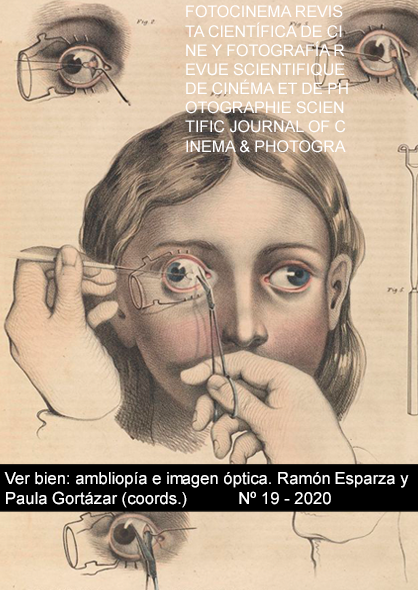Shame (2011) by Steve McQueen. Cinema in the second degree: Hypertextuality
DOI:
https://doi.org/10.24310/Fotocinema.2019.v2i19.6653Keywords:
Transtextuality, Hypertextuality, Gérard Genette, Shame, Steve McQueen, American Psycho, Mary Harron, Bret Easton EllisAbstract
The aim of this paper is to suggest the existence of a transtextual relationship of hypertextuality between Shame (2011), a film by the British director Steve McQueen, and American Psycho (2000) by Mary Harron (on the novel by Bret Easton Ellis [1991]). Firstly, this thesis is supported both by the similarity of the plots and the filmmaking elements, as well as by the artistic intention of their directors. In a subsequent second part of this essay, another series of intertextual allusions from different sources in McQueen’s film will be identified and analysed. As a result, the film becomes a meaningful transtextual palimpsest which provides its own meaning from the combination of meanings of its underlying texts. Paraphrasing Gérard Genette’s words, the French literary theorist whose methodology has been used in the present analysis, Steve McQueen’s Shame is a good example of “cinema in the second degree”.
Downloads
Metrics
References
Algeo, J. (1991). Fifty Years Among the New Words: A Dictionary of Neologisms. Cambridge: Cambridge University Press.
Allen, G. (2000). Intertextuality. London-New York: Routledge.
Baelo Allué, S. (2002). The aesthetics of serial killing: Working against ethics in The Silence of the Lambs (1988) and American Psycho (1991), Atlantis. Revista de la Asociación Española de Estudios Anglo-Norteamericanos, 24.2, 7-24.
Díaz Gito, M.A. (2019). El Infierno, según Steve McQueen. Shame (2011) y las Hijas de Dánao, International Journal of the Classical Tradition, 26, en prensa.
Featherstone, M. (2016). Carnotopia: The Culture of Sadism in Nymphomaniac, Shame and Thanatomorphose. En J. Gwynne (Ed.), Transgression in Anglo-American Cinema: Gender, Sex and the Deviant Body (pp. 25-42), London-New York: Wallflower Press.
Genette, G. (1989). Palimpsestos. La literatura en segundo grado. Madrid: Taurus (=1982).
González Etxeberria, J. (2017). Epopeyas postmodernas y topografías infernales sin salida. En J. M. Losada & A. Lipscomb (Eds.), Myth and Emotions (pp. 279-290). Cambridge: Cambridge Scholars Publishing.
Holtsmark, E.B. (2001). The Katabasis Theme in Modern Cinema. En M.M. Winkler (Ed.), Classical Myth and Culture in the Cinema (pp. 23-50). Oxford: Oxford University Press [=Classics and Cinema (1991)].
Holtsmark, E.B. (1997). Films and Ring Composition. KLEOS. Estemporaneo di Studi e Testi sulla Fortuna dell’Antico, 2, 271-274.
Kauffman, L. (2000-2001). American Psycho, Film Quarterly, 54.2, 41-45.
Kooijman, J. & T. Laine (2003). American Psycho: A double portrait of serial yuppie Patrick Bateman, Post Script, 22.3, 46-57.
Kristeva, J. (1986). Word, Dialogue and Novel. En T. Moi (Ed.), The Kristeva Reader (pp. 34-61). New York: Columbia University Press.
Lee, C. (2013). Shopping and Slaying, Fucking and Flaying: Serial Consumption in American Psycho. En A. MacDonald (Ed.), Murders and Acquisitions: Representations of the Serial Killer in Popular Culture (pp. 105-122). New York: Bloomsbury.
Marinkovich, J. (1998-1999). El análisis del discurso y la intertextualidad, Boletín de Filología de la Universidad de Chile, 37, 729-742.
Pardo García, P.J. (2010). Teoría y práctica de la reescritura filmoliteraria (A propósito de las reescrituras de The Turn of the Screw). En J.A. Pérez Bowie (Ed). Reescrituras fílmicas. Nuevos territorios de la adaptación (pp. 45-102). Salamanca: Universidad.
Pérez Bowie, J.A. (ed.) (2010). Reescrituras fílmicas. Nuevos territorios de la adaptación. Salamanca: Universidad.
Pérez Bowie, J.A. (2008). Cine e Intertextualidad. En Idem, Leer el cine. La teoría literaria en la teoría cinematográfica (pp. 151-167). Salamanca: Universidad.
Robinson, D. (2006). The Unattainable Narrative: Identity, Consumerism and the Slasher Film in Mary Harron’s American Psycho, CineAction, 68, 26-35.
Sánchez-Escalonilla, A. (2005). The Hero as a Visitor in Hell. The Descent into Hell in Film Structure, Journal of Popular Film and Television 32.4, 149-156.
Stam, R. (2005). Introduction: The Theory and Practice of Adaptation. En R. Stam & A. Raengo (Edd.), Literature and Film. A Guide to the Theory and Practice of Film Adaptation (pp. 1-52, esp. 26-31). Malden-Oxford: Blackwell Publishing.
Downloads
Published
How to Cite
Issue
Section
License
All contents published in Fotocinema Revista científica de cine y fotografía are protected under the Creative Commons Attribution-NonCommercial-ShareAlike 4.0 International (CC BY-NC-SA 4.0) license. All about this license is available in the following link: <http://creativecommons.org/licenses/by-nc-sa/4.0>
Users can copy, use, redistribute, share and exhibit publicly as long as:
- The original source and authorship of the material are cited (Journal, Publisher and URL of the work).
- It is not used for comercial purposes.
- The existence of the license and its especifications are mentioned.
There are two sets of authors’ rights: moral and property rights. Moral rights are perpetual prerogatives, unrenounceable, not-transferable, unalienable, imprescriptible and inembargable. According to authors’ rights legislation, Fotocinema. Revista científica de cine y fotografía recognizes and respects authors moral rights, as well as the ownership of property rights, which will be transferred to University of Malaga in open access. The property rights are referred to the benefits that are gained by the use or the dissemination of works. Fotocinema. Revista científica de cine y fotografía is published in an open access form and it is exclusively licenced by any means for doing or authorising distribution, dissemination, reproduction, , adaptation, translation or arrangement of works.
Authors are responsable for obtaining the necessary permission to use copyrighted images.













13.png)




